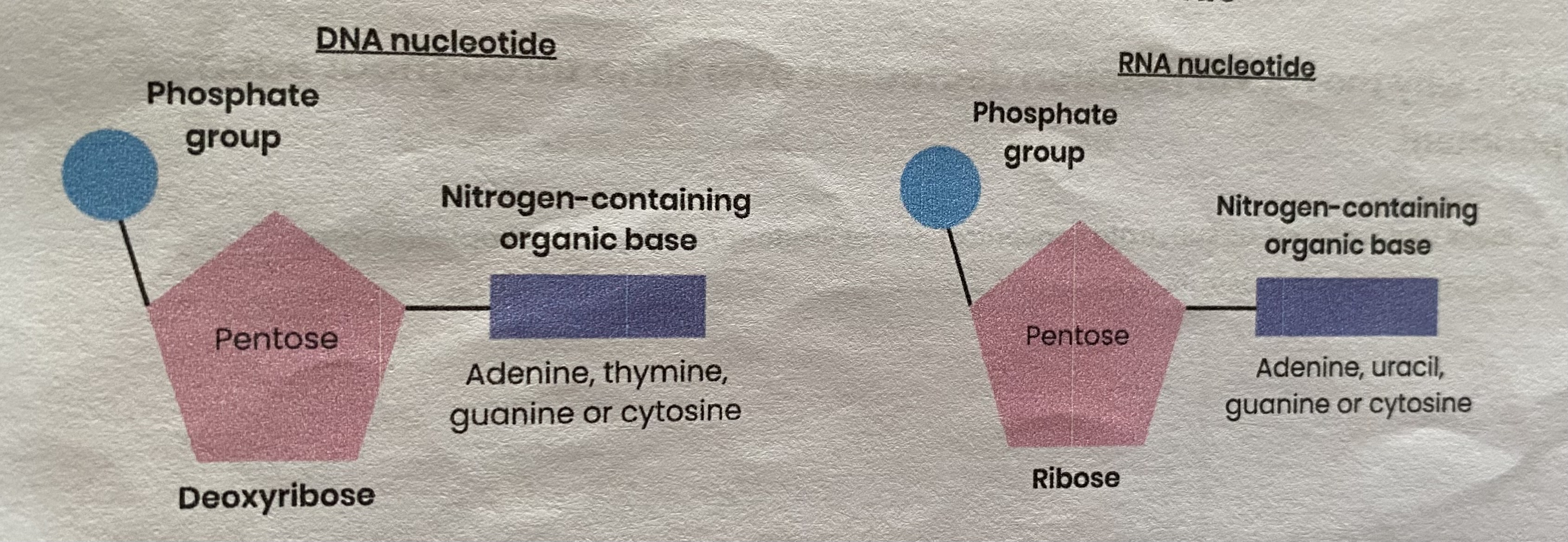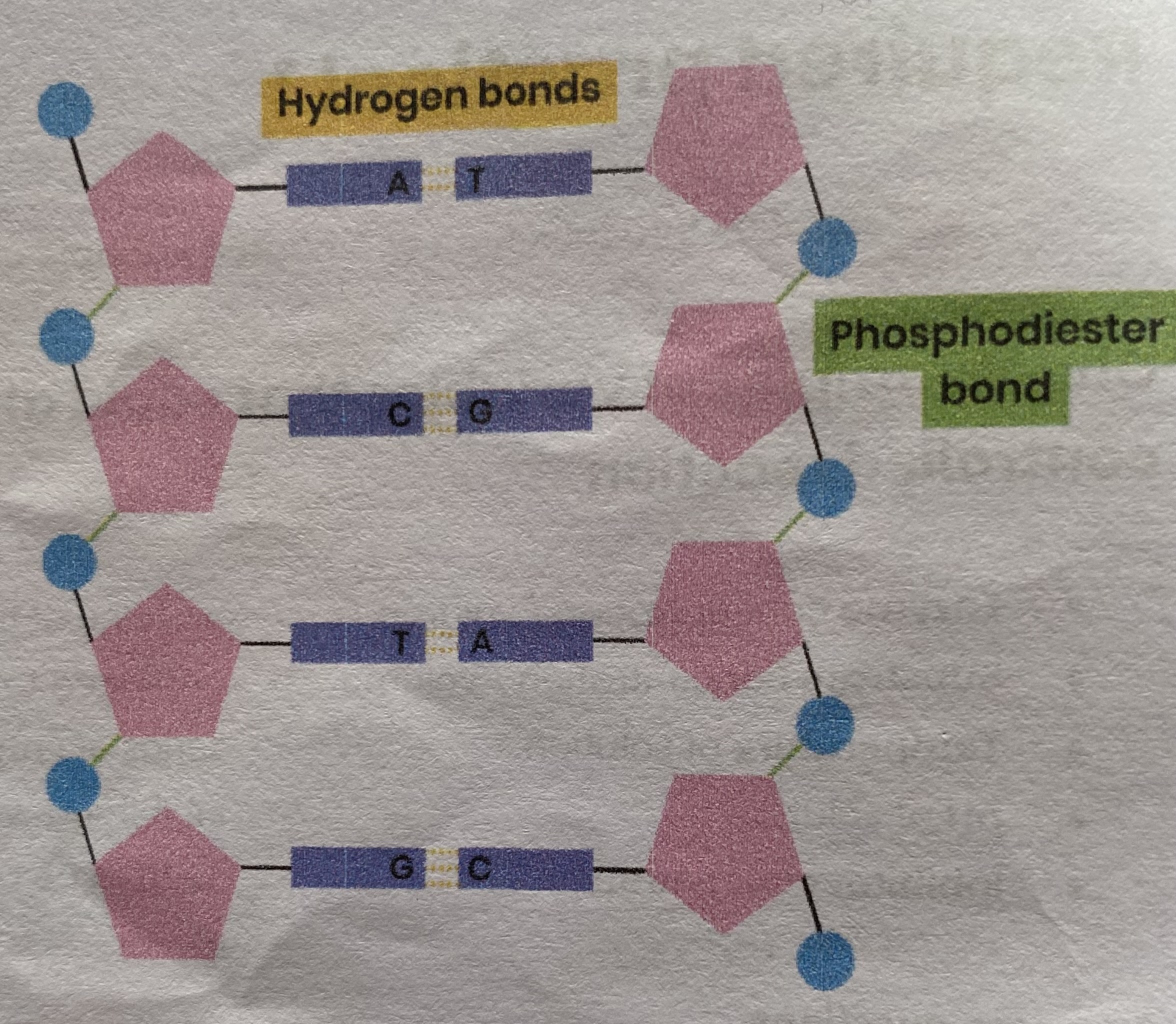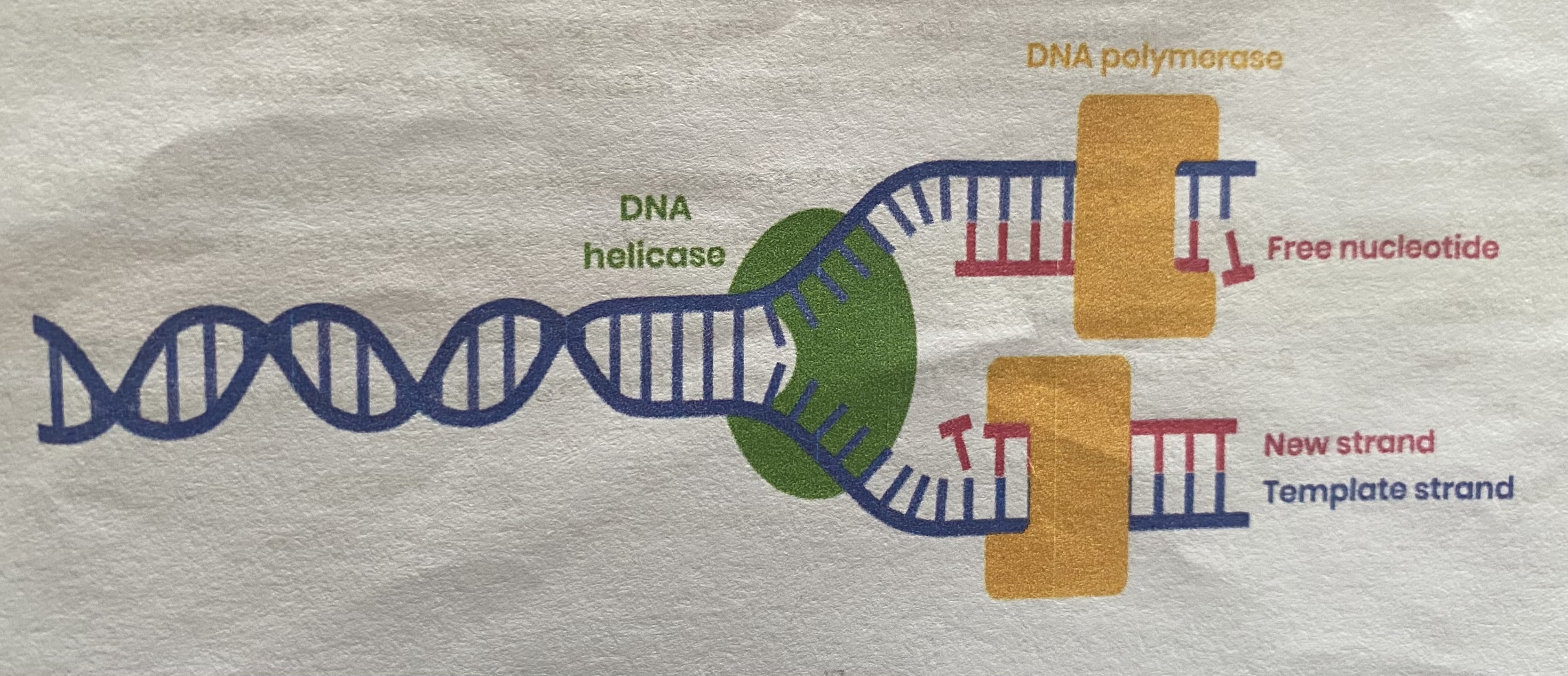1- Structure of DNA and RNA, DNA replication
1/16
There's no tags or description
Looks like no tags are added yet.
Name | Mastery | Learn | Test | Matching | Spaced |
|---|
No study sessions yet.
17 Terms
Describe the basic functions of DNA + RNA in all living cells
DNA= holds genetic information which codes for polypeptides (proteins)
RNA= transfers genetic information from DNA to ribosomes
Name the 2 types of molecule from which a ribosome is made
RNA
Protein
Draw and label a DNA nucleotide and an RNA nucleotide

Describe the differences between a DNA nucleotide an an RNA nucleotide
DNA:
pentose sugar is deoxyribose
base can be thymine
RNA:
pentose sugar is ribose
base can be uracil
Describe how nucleotides join together to form polynucleotides
condensation reactions, removing water molecules
between phosphate group of one nucleotide and deoxyribose/ ribose of another
forming phosphodiester bonds
Why did many scientists initially doubt that DNA carried the genetic code?
The relative simplicity of DNA- chemically simple molecule with few components
Describe the structure of DNA
Polymer of nucleotides (polynucleotides)
Each nucleotide formed from deoxyribose, a phosphate groups and nitrogen-containing organic base
Phosphodiester bonds join adjacent nucleotides
2 polynucleotide chains held together by hydrogen bonds
Between specific complementary base pairs- adenine/ thymine and cytosine/ guanine
Double helix

Describe the structure of (messenger) RNA
Polymer of nucleotides (polynucleotide)
Each nucleotide formed from ribose, a phosphate group and a nitrogen-containing organic base
Bases- uracil, adenine, cytosine, guanine
Phosphodiester bonds join adjacent nucleotides
Single helix
Compare and contrast the structure of DNA and (messenger) RNA
DNA:
Pentose sugar is deoxyribose
Has the base thymine
Double stranded/ double helix
Long (many nucleotides)
Has hydrogen bonds/ base pairing
RNA:
Pentose sugar is ribose
Has the base uracil
Single stranded/ single helix
Shorter (fewer nucleotides)
Doesn’t have hydrogen bonds
Suggest how the structure of DNA relates to its function
2 strands= both can act as templates for semi-conservative replication
Hydrogen bonds between bases are weak= strands can be separated for replication
Complementary base pairing= accurate replication
Many hydrogen bonds between bases= stable/ strong molecule
Double helix with sugar phosphate backbone= protects bases/ hydrogen bonds
Long molecule= store lots of genetic information (that codes for polypeptides)
Double helix (coiled)= compact
Suggest how you can use incomplete information about the frequency of bases on DNA strands to find the frequency of other bases
% of adenine in strand 1= % of thymine in strand 2 (vice versa and for cytosine and guanine)
because of specific complementary base pairing between 2 strands
Why is semi-conservative replication important?
ensures genetic continuity between generations of cells
Describe the process of semi-conservative DNA replication
DNA helicase breaks hydrogen bonds between complementary bases, unwinding the double helix (separating the strands)
Both strands act as templates
Free DNA nucleotides attracted to exposed bases and join by specific complementary base pairing
Hydrogen bonds form between adenine-thymine and guanine-cytosine
DNA polymerase joins adjacent nucleotides on new strand by condensation reactions
Forming phosphodiester bonds

Why is it called semi-conservative?
each new DNA molecule consists of one original/ template strand and one new strand
Use your knowledge of enzyme action to suggest why DNA polymerase moves in opposite directions along DNA strands
DNA has antiparallel strands
so shapes/ arrangements of nucleotides on 2 ends are different
DNA polymerase is an enzyme with a specific shaped active site
so can only bind to substrate with complementary shape (phosphate end of developing strand)
Name the 2 scientists who proposed models of the chemical structure of DNA and of DNA replication
Watson and Crick
Describe the work of Meselson and Stahl in validating the Watson-Crick model of semi-conservative replication
Bacteria grown in medium containing heavy nitrogen (15N) and nitrogen is incorporated into DNA bases
DNA extracted & centrifuged= settles near bottom, as all DNA molecules contain 2 ‘heavy’ strands
Bacteria transferred to medium containing light nitrogen (14N) and allowed to divide once
DNA extracted & centrifuged= settles in middle, as all DNA molecules contain 1 original ‘heavy’ and 1 new ‘light’ strands
Bacteria in light nitrogen allowed to divide again
DNA extracted & centrifuged= half settles in middle, as contains 1 original ‘heavy’ and 1 new ‘light' strand, half settles near top as contains 2 ‘light’ strands
